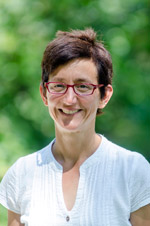Light-up football. Alarm backpack. Solar-powered MP3 hoodie. Recycled talking bear.
These are just a few of the inventions created by youth makers in Lansing, Mich. and Greensboro, N.C. to tackle injustice in their own community.

A student works on a maker project in the GET City program, located at the Boys and Girls Club.
For more than 10 years now, their passion has been spilling beyond the walls of their Boys and Girls Clubs, into their local schools and museums and to scholars striving to improve science education nationwide.
That’s because behind the hundreds of projects and expressions of social change led by these youth, there is a Michigan State University researcher who has been studying—and empowering—new ways of thinking about engagement in STEM learning.

Angela Calabrese Barton
Professor of teacher education Angela Calabrese Barton is being honored for making a real, sustained impact in practice as the recipient of the American Educational Research Association’s Exemplary Contributions to Practice-Engaged Research award. She received the recognition during the AERA meeting on April 15.
“She has devoted her career, in research and in practice, to addressing fundamental equity concerns faced by teachers and youth in formal/informal educational settings, with special attention to the challenges faced by youth and their teachers from historically marginalized communities,” wrote fellow teacher education Professor Patricia Edwards in her award nomination letter. “She is truly an exceptional person and scholar who I see as a beacon of light.”
A different movement
Calabrese Barton runs the GET City (Green Energy Technologies) afterschool and summer program at the Lansing Boys and Girls Club in partnership with longtime collaborator Edna Tan, who leads GET City at a Boys and Girls Club in Greensboro, N.C. Tan is an associate professor at University of North Carolina at Greensboro. Previously, she was a postdoc working with Calabrese Barton at MSU.
Over time, the program activities have shifted from a focus on engineering concepts to making, the iterative process of inventing or manufacturing that has become a growing movement in the education field.
Calabrese Barton explored the maker movement with a grant from the W.T. Grant Foundation’s Distinguished Fellows Program that allowed her to embed in makerspaces. Through that experience, she helped develop the Think Tank makerspace at Impression 5 Science Center. She also helped the Lansing Boys and Girls Club youth create their own new makerspace.

Calabrese Barton works with a student in the makerspace at Impression 5 Science Center.
As the programs evolved, so did the research. Calabrese Barton and Tan have just published the most comprehensive look at findings from their approach to making in the American Educational Research Journal (AERJ). The study, which documents the development of 41 youth maker projects over four years, shows how STEM-oriented making can lead to powerful breakthroughs in learning and agency for students of color and from low-income backgrounds.
Their ability to provide a sustained (twice weekly throughout most of the year) program is key, as well as the focus on community—being within the kids’ own turf, and encouraging them to conduct their own ethnographies and tap into community members’ wisdom.
The research team also has a new book, “STEM-Rich Maker Learning” (Teachers College Press), coming out this summer. They received a new, $1.4 million grant from the National Science Foundation to continue their work over the next four years.
Making bridges
Calabrese Barton is committed to finding ways to bridge informal learning experiences like GET City with school-based learning. Materials that were developed for another project, called iEngineering, are now being implemented in Lansing and Greensboro schools.
In collaboration with sixth-grade teachers at Lewton and Sheridan Road Elementary Schools in Lansing, students are using a maker process and engineering design skills to come up with solutions to problems in their own classroom. There is a focus on environmental sustainability.
One group, for example, addressed the sensitive issue of kids barging in on classmates using the in-classroom bathroom by creating an exterior LED-light system that indicates when the bathroom is in use. They also created a video to document the project.
Students participating in Calabrese Barton’s research often share their work through multimedia, community events and workshops for adults or peers. It’s all part of striving for a true practice partnership—the kind of collaboration outlined by the AERA award.
“For research to have real impact on practice, it has to be attuned to the needs of the practice-based setting, as well as to the experiences and perspectives, knowledge and wisdom of all of the participants,” Calabrese Barton said. “It’s not only, ‘These are the things I want to learn for myself, but here’s what I want to teach others.’ And that’s not only important for the participants, but for the community.”
Related links
Calabrese Barton, who in 2015 was recognized with a William J. Beal Outstanding Faculty Award at MSU, was named an AERA Fellow during the organization’s annual meeting in 2017.